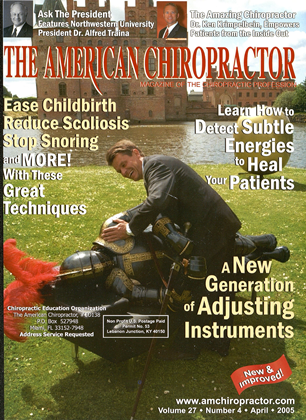C HIROPRACTIC IS AN INCREDIBLY 01-verse profession, boasting more than 100 different techniques (one list puts the number closer to 120 and one online source even claims there are 200). Some are extremely well known, such as Diversified or Atlas Orthogonal Technique. Others possess a smaller (but often extremely loyal) following, such as the McTimody Technique or the Columbia Technique. Most doctors incorporate several techniques into their practices and many attend frequent seminars to learn new techniques in the hope of improving the quality of care they provide patients. While this array of techniques contributes to the rich texture of our pro- fession, developing a technique requires more than merely modifying an adjusting table and giving seminars. Craig Nelson. DC, in an article titled "The Nelson Method—Five Steps to Your Own Technique" (Journal of Manipulative and Physiological Therapeutics, vol. 16, No. 2 Feb. 93, pp.115-117), gave facetious advice on how to start a technique. After suggestions about corning up with a name and sounding scientific ("complicated mathematical equations work really well"), he advised, "Don't attempt to test the reliability or effectiveness of your technique. You do not want to ask questions you do not know the answer to." Luckily for chiropractic, and chiropractic patients, most developers ignored that last piece of advice and conducted at least some—often extensive—research on their techniques before introducing them to the profession. But the lack of solid research into chiropractic, in general, and techniques in particular, is distressing and has not gone unnoticed by our critics. An online information page put out by AETNA insurance notes that, "There are more than 100 chiropractic and spinal manipulative adjusting techniques, and practitioners may vary in their approaches." The page goes on to make such statements as, "Overall, the quality of studies has been poor. Better-quality research is necessary to make a clear conclusion," (referring to neck pain). "However, because of weaknesses in this research, no clear conclusions can be drawn," (referring to asthma). "Because there are a limited number of studies in humans and weaknesses in existing research, it is unclear if chiropractic techniques are beneficial...." (Referring to just about everything else). The lack of high-quality research is a problem we must address, if chiropractic is to be accepted by the public; and technique developers are in an ideal position to help compile that research. According to the Council on Chiropractic Practice (CCP) Guidelines, "Techniques and methods for correcting subluxation must be judged on their intended outcome and most, if not all, chiropractic techniques have some physiological and/or structural outcome that measures their results." In fact, outcomes research is the key to establishing or choosing any technique. Our profession cannot afford to use or promote a technique out of blind loyalty or habit. As with every other aspect of chiropractic, we have to look at the literature and make sure the technique is the result of scientific research. Preferably, lhat research will have been published in a peer-reviewed journal, either by the developer or by doctors who use the technique in their practices. Erin Elster. DC, whose research has been published in the Journal of Vertebral Subluxation Research, JMPT, and Today's Chiropractic, has stated, "1 encourage all doctors of chiropractic to publish their research using their chiropractic techniques and technologies, in order to expand the chiropractic knowledge base and to benefit the profession." The quality and amount of research on techniques is also critical in the development of chiropractic practice guidelines. Since chiropractors often define themselves and their services by the techniques they use, professional guidelines must address those techniques. "The involvement of technique experts is crucial to the development of any chiropractic guideline," states Matthew McCoy, DC, Vice President of the Council on Chiropractic Practice. "Unfortunately these dedicated and unsung heroes have effectively been shut out of other groups' guideline development efforts and the research community. Instead, they need to be deeply involved in this process, since the art of chiropractic is the application of the philosophy and science." Involving technique experts in both research programs and guideline development has far-reaching benefits for the profession and for patients. Not only will it ensure the continued safety of chiropractic adjustments, but it will enable doctors to provide the evidenced-based care demanded by the public today. Dr. Jackson is Chief Executive Officer. Research and Clinical Science (RCS). a private sector research program exploring issues of suhluxation correction and chiropractic care as they relate to health and wellness. Previously, he served as president of Chiropractic Leadership Alliance and treat- ing li'ellness Alliance, lie was owner/operator of several private practice offices in C 'alifornia ami Idaho that specialized in high volume, family wellness based care. Or. Jackson may be reached at MHt-V(M-13M; or, for more infitrmation. contact Barbara Bigham at 50}-362-2M5. TECHNIQUES & ADJUSTING PROCEDURES IN THIS ISSUE pg. 22 Snoring and Sleep Apnea—Structural Complications by Dr. George Roth pg. 24 The Evolution of Bloodless Surgery and Chiropractic by Dr. Charles L. Blum pg. 26 Manipulation Under Anesthesia or Joint Anesthesia by Dr. Peter M.Ferraro pg. 28 Reduce Spinal Scoliosis Without Braces or Surgery by Dr. R. B. Mawhiney pg. 30 The Webster Technique in Pregnancy by Dr. Jeanne Ohm, pg. 32 Trigenics® Myoneural Medicine: A Neurological Treatment System by Drs. James Fung, Philip McAllister, and Allan Oolo Austin pg. 36 A Primal Perception Approach by Dr. Robert Wiegand
 View Full Issue
View Full Issue






